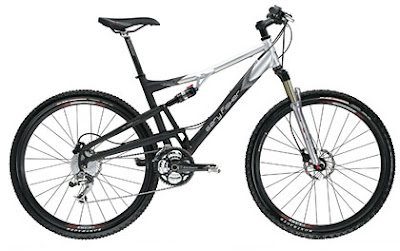
Gary Fisher Superfly
( Carbon Frame & Made in the USA! )
There's a few very good reason's why so many of us ride and race 29er mountain bikes. It's all about the big Mo, Momentum, that is... You see, 29" wheels are bigger than 26" wheels. And the bigger the wheel, the smaller (relatively speaking ) the stuff the wheel rides over, thus decreasing your angle of attack. Why is this important or why should you care? Reducing the angle of attack lets you roll over obstacles faster, smoother and easier than you can with smaller wheels. Another great thing about the 29er wheel is how it creates a longer contact patch with the trail. (think snow shoes) Now the longer-contact-patch is very key, this helps you float through mud, sand, snow, and also improves traction when climbing. Not getting bogged down helps you maintain your momentum, this is a very good thing. Which brings us back to momentum. The great science type people of Pepperdine University found that 29" wheels ride 6 percent faster on uphill courses and 3 percent faster on cross-country courses than their 26" cousins.* This happens because 29er wheels are less affected by dips, bumps, roots, rocks and soft terrain than smaller wheels. Oh, and the Fisher design helps stability by lowering the rider's center of gravity in relation to the axle. (Complements of Fisher Genesis geometry - a tale for another post. So, to summarize , 29er wheels equal increased momentum. Increased momentum equals more speed. More speed equals profound joy and happiness due to more singletrack ridden by sundown. And to clear up one myth, 29er bikes fit riders of all sizes, tall or short. After all I should know and I'm not tall!
( Single-Speed )
And now with the G2 geometry the 29er's ride is increadible! G2 Geometry started out as a project to improve the slow-speed handling of Fisher bikes. Fisher's existing Genesis Geometry already excelled in climbing, descending and handling at speed. The one area we wanted to improve its handling was in tight singletrack and technical climbs.
True Temper OX Platinum (Steel) 29 w/eccentric bottom bracket
As they say, "Steel is real."
G2 accomplished this by increasing the amount of fork offset. This reduced the amount of trail to make it steer quicker without changing the rest of its handling characteristics. While increasing the offset, we reduced the reach to the handlebar to allow the rider to weight the front wheel more accurately.
The difference between too much trail and too little has been experienced by all of us. Think about going around a really sharp turn: take it too tight, and too slow, and you'll dab to the inside. You've oversteered.
Fisher Race Day 6066 T6 aluminum main frame
Now think about the last time you over shot the same turn: you've understeered and ended up in the woods. Why does this happen? A good part of steering performance rests in the amount of trail. Too much trail and you'll oversteer (some feel this as wheel flop or dive) at slow speeds and understeer (overshoot the corner) at high speeds. Too little trail and you'll understeer at slow speeds and oversteer (feels twitchy) at high speeds.
*Source : Summary of the Gary Fisher Bicycles Two-Niner Project by Holden S-H. MacRae, Ph D.







1 comment:
Awesome article. I've always wondered what the big hype was. I'm a XC racer but as yet am to see anyone on a 29er. What is the difference between the 29er and the 26" wheels? I've heard they both have the same BSD
Post a Comment